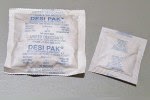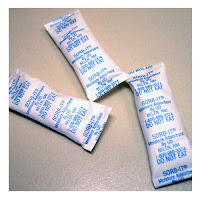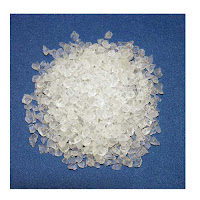Your Time Capsule's Inside Environment
Common Questions...
We are often asked how we calculate the How Much Silica Gel Do I Use in My Time Capsule? included in each of our time capsules and packages. What do we mean by 'conditioners'? They are the packets of drying-out agents (desiccant, Silica Gel Packets) and oxygen-eating agents (Ageless Oxygen Absorbers) that help to condition the air in a closed time capsule over time. Common questions are also asked when considering a museum’s environment for an exhibit case, but the first 4 might be done away with if you have a proper time capsule container. It gives us a starting point of discussion.4 We Don't Care About:
1. What is the difference in RH between the enclosure and the room?2. What is the permeability and air leakage of the enclosure?
3. What is the stability of the overall room temperature?
4. What is the desired maintenance cycle?
 |
| Desiccant and silica gel control moisture inside the container. |
Just forget about these things for time capsule environment purposes. We're not too concerned about these 4 because a time capsule is not an exhibit case. A time capsule is special. It is a well sealed airtight rigid container. Assuming customers follow our guidelines about not subjecting it to changes in temperature (i.e., don't place it outdoors above ground) and how it seals (don't use a FOAM or plain rubber gasket, e.g.), they don’t need to worry too much about changing the desiccant. In a museum’s exhibit case, the conditioners need to be frequently changed. But in a time capsule, you leave it alone – static conditioning is okay so long as the time capsule and its surrounding environment are stable. Consider these others, however.
What We DO Care About:
5. How vulnerable is the item to humidity (or the lack of it)?
We all know what can happen to paper as it takes on moisture – fungi, mold, foxing.But what about too much dryness? At one time I worried, “Are we making the environment too dry inside of our time capsule containers?” But studies done on papers and books indicated a 20% humidity worked as well if not better than 50-60%. All of our silica gel and desiccant products are provided at the 20% level. If you have something sensitive to dryness (i.e., leather), you could consider preconditioning it yourself or use the MVP bags inside of the dry time capsule.
Consider first the type of items you have and then consider what each needs.
6. What is the volume of the enclosure?*
Consider two box examples, shown below. Time Capsule Box A measures 12x12x12” and has a cubic volume of 1728 cu. in. (12x12x12). Time Capsule Box B measures 12x12x24” and has twice that volume or 3456 cu. in. (12x12x24). It would follow that Time Capsule B will need more conditioning than Time Capsule A. However, what if Time Capsule A is almost empty, while Time Capsule B is almost full? Just how much control is needed? Does it matter what Time Capsule B is full of?We don't show a cylinder example for this exercise, but we do show you how to calculate it below. It's apparent that the cylinder shape does not afford the same usable volume that the box shape does.
7. How much relative humidity control is needed?
Let’s assume you don’t need to worry about the time capsule container (this is true if it's one of ours). It’s stainless steel and airtight and placed in an area that’s got stable temperature (no changes). That’s a big assumption, but an important one, because it allows us not to worry about the things museums do – constant changes in relative humidity and temperature from the room the artifacts are housed in and the building, too. Not even the Crypt of Civilization is intended to be walked in and out of frequently.So, the amount of humidity control you need in a time capsule is dependent not only upon the items placed inside but also the air space left over after items are inside. You could have a lot of paper (paper contains moisture) or you could have a lot of plastics and toys and such (not much moisture). It follows that you will want to use more desiccant in the capsule if it has more paper than artifacts inside. Air space inside will have oxygen and moisture in it, too – it’s not really empty. So you'll want to allow for that.
Rule of Thumb for Time Capsule Desiccants
Here is a rule of thumb chart that is used for any rigid container such as our time capsules. The amount you end up using will depend on the items’ characteristics. Mostly paper contents? Use extra desiccant.
Know Your Volume
First, determine the volume of your capsule.
Box Shapes
For a box, it's easy. Just take Length times Width times Height (LWH).
A box that measures 12" x 12" x 24" gives you 3456 cubic inches. One that's 12" x 12" x 12" is 1728 cu. in.
Cylinder Shapes
If you wish to see how a cylinder compares to a box in volume, let's use a cylinder that measures 12" in diameter and 24" in height.
First, you need the basic formula, a bit more complicated than the box's:
PI x Radius x Radius x Height, or πr2h
Now plug in the numbers.
For Pi, let's use 3.14159.
Since the radius is half of the diameter, our radius value is 6" (half of 12").
Measure the height (24").
It's easy to see that you get less volume in a cylinder of 12” d x 24” (3.14159 x 6 x 6 x 24" = 2714 cu. in.) when compared with a box of 12 x 12 x 24” (12 x 12 x 24" = 3456 cu. in.).
The chart below shows a comparison of time capsule volume and the amount of desiccant or silica gel commonly recommended for it - which you can increase according to the amount of moisture content.
Simple Manufacturer’s Chart for Desiccant/Silica Gel
Simple Manufacturer’s Chart for Desiccant/Silica Gel
(by Container Volume) | ||
Time Capsule
Volume (Cubic Inches)
| Units Desiccant (Empty Capsule) | Grams Silica Gel (Empty Capsule) |
237-475
| 1/6 | 2 |
476-714
| 1/3 | 4 |
715-1428
| ½ | 6 |
1429-2856
| 1 | 12 |
2857-4285
| 2 | 24 |
4286-5713
| 3 | 36 |
5714-7142
| 4 | 48 |
7143-8570
| 5 | 60 |
Know your Time Capsule Contents
No one places an empty time capsule. You'll have items inside. Now let's consider some items and how you adjust for them.
Adjusting for Paper Content
How much of your time capsule contents are paper? Think of a ream of paper. You might have a City Budget that's about half that size. If a ream of paper weighs 5 lbs, then your budget would be about 2.5 lbs. So the rule of thumb for paper items (the most moisture laden materials) is this:
Add 1/2 Unit of Desiccant for each 100 sheets of paper (or each pound of the paper product's total weight). Taking 2.5 times 1/2 u. = about 1 and 1/2 U desiccant for that one item.If using silica gel, add at least 10 grams extra for each 100 sheets or 1 lb. The weight of your paper may vary, but in general, figure 500 sheets of basic 20#wt paper (a 'ream') weighs about 5 lbs. Silica gel is best used for smaller container sizes such as our cylindrical family style time capsules or smaller. Desiccant works just as well as silica gel for time capsule purposes, and you won't need as much.
Adjusting for Oxygen Absorbers
If you use Oxygen Absorbers, you may need a bit more. In addition to what you need above, use this rule of thumb:Use at least 10 g of silica gel or 1/2 unit of desiccant to every 1000 cc oxygen absorber in your time capsule.
Figuring how many oxygen absorbers you need to begin with is a different process and I will cover that in another article.
A Tale of 2 Time Capsules
Here's a comparison of two stainless steel time capsule boxes:
Time Capsule Box A
|
Time Capsule Box B
|
|
12" x 12" x 12"
|
12" x 12" x 24"
|
|
Volume: 1728 cu in.
|
Volume: 3456 cu in
|
|
Model: 42172 Ganymede
|
Model: 42350 Neptune
|
|
Contents: Just a few paper items
|
Contents: About ½ full of paper items
(4 Reams or 2000 paper sheets or 20 lbs) |
And here's how you might calculate the desiccants needed for each:
Total Suggested Using Chart plus Adjustments for Paper, Ageless
| |
Time Capsule Box A
|
Time Capsule Box B
|
Empty: 1-1/2 Units
|
Empty: 2-1/2 Units
|
Paper: N/A
|
Paper: 20 lbs est., Add: 10 Units
|
2,000 cc Ageless: Add 1 Unit
|
3,000 cc Ageless: Add 3 Units
|
Total for Ganymede: 2-1/2 Units
|
Total for Neptune: 15-1/2 Units
|
As you can see from the above chart for volume, the makers of desiccant and silica gel have made the cubic inch recommendations conform to the size of packets they make. You will need to take the volume in cubic inches of your time capsule container and apply it to the above chart. For instance, 1728 falls in between 1429 and 2856 on the chart above. If you used estimated interpolation you might give empty Time Capsule A 1 ½ units rather than just 1, and empty Time Capsule B 2 ½ units rather than just 2.
We include desiccant conditioners with all of our time capsules, and in most cases, we give you plenty. If you get a Preservation Enclosures Kit, you get even more. Check out the contents listing for our large K3 time capsule preservation kit, for 56701 (the 1 unit pack), you'll see that it has 8 units. You can use the rules of thumb above to determine if you need more than we provide. There's no way for us to know what your contents are made of in advance, so it's good for you to know some common sense ways to figure a good amount for your own project.
Supplement it by adding more Desiccant or Silica Gel from our online store. Like the Oxygen Absorbers, they are quite inexpensive for all the good they do! You can order more desiccant products from us directly in the following amounts:
56610. 10 gram Silica Gel.
56700. 1/2 Unit DesiPak.
56701. 1 Unit DesiPak.
56702. 2 Unit DesiPak.
I realize this is a lot of information to just throw at you, so if you have any problems with your calculations please give us a call or email - and please visit us at Future Packaging & Preservation.
(c) 2013 Janet Reinhold. Updated to reflect our new site on 9/1/2016; updated again 2/20/2018
No liability is assumed with respect to the advice given here.

